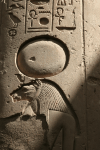A lot of the information on this page is from The Ancient Egypt Site (AES below), the site Ancient Egypt (AE below), and from Wikipedia. These sites have a lot of information and consistent time lines, although they differ. The hieroglyphic names are from both the AES and AE website. The times are all from the AE website.
From the Second Intermediate Period of Egypt entry in Wikipedia:
The Second Intermediate Period marks a period when ancient Egypt fell into disarray for a second time, between the end of the Middle Kingdom and the start of the New Kingdom. The concept of a "Second Intermediate Period" was coined in 1942 by German Egyptologist Hanns Stock.
It is best known as the period when the Hyksos people of West Asia made their appearance in Egypt and whose reign comprised the 15th Dynasty founded by Salitis.
The 12th Dynasty of Egypt came to an end at the end of the 19th century BCE with the death of Queen Sobekneferu (1782–1778 BCE). Apparently she had no heirs, causing the 12th Dynasty to come to a sudden end, and, with it, the Golden Age of the Middle Kingdom; it was succeeded by the much weaker 13th Dynasty. Retaining the seat of the 12th Dynasty, the 13th Dynasty ruled from Itjtawy ("Seizer-of-the-Two-Lands") for most of its existence, switching to Thebes in the far south possibly since the reign of Merneferre Ay.
The 13th Dynasty is notable for the accession of the first formally recognised Semitic-speaking king, Khendjer ("Boar"). The 13th Dynasty proved unable to hold on to the entire territory of Egypt however, and a provincial ruling family of Western Asian descent in Avaris, located in the marshes of the eastern Nile Delta, broke away from the central authority to form the 14th Dynasty.
The 15th Dynasty dates approximately from 1624 to 1514 BCE.
The 15th Dynasty of Egypt was the first Hyksos dynasty. It ruled from Avaris but did not control the entire land. The Hyksos preferred to stay in northern Egypt since they infiltrated from the northeast. The names and order of their kings is uncertain. The Turin King list indicates that there were six Hyksos kings, with an obscure Khamudi listed as the final king of the 15th Dynasty.
Some scholars argue there were two Apophis kings named Apepi I and Apepi II, but this is primarily due to the fact there are two known prenomens for this king: Awoserre and Aqenenre. However, the Danish Egyptologist Kim Ryholt maintains in his study of the Second Intermediate Period that these prenomens all refer to one man, Apepi, who ruled Egypt for 40 or more years. This is also supported by the fact that this king employed a third prenomen during his reign: Nebkhepeshre. Apepi likely employed several different prenomens throughout various periods of his reign. This scenario is not unprecedented, as later kings, including the famous Ramesses II and Seti II, are known to have used two different prenomens in their own reigns.
The 16th Dynasty ruled the Theban region in Upper Egypt for 70 years.
The continuing war against the 15th Dynasty dominated the short-lived 16th Dynasty. The armies of the 15th Dynasty, winning town after town from their southern enemies, continually encroached on the 16th Dynasty territory, eventually threatening and then conquering Thebes itself. In his study of the second intermediate period, the egyptologist Kim Ryholt has suggested that Dedumose I sued for a truce in the latter years of the dynasty, but one of his predecessors, Nebiryraw I, may have been more successful and seems to have enjoyed a period of peace in his reign.
Famine, which had plagued Upper Egypt during the late 13th Dynasty and the 14th Dynasty, also blighted the 16th Dynasty, most evidently during and after the reign of Neferhotep III.
Thebes was the capital of many of the 16th Dynasty pharaohs. From Ryholt's reconstruction of the Turin canon, 15 kings of the dynasty can now be named, five of whom appear in contemporary sources. While they were most likely rulers based in Thebes itself, some may have been local rulers from other important Upper Egyptian towns, including Abydos, El Kab and Edfu. By the reign of Nebiriau I, the realm controlled by the 16th Dynasty extended at least as far north as Hu and south to Edfu. Not listed in the Turin canon (after Ryholt) is Wepwawetemsaf, who left a stele at Abydos and was likely a local kinglet of the Abydos Dynasty.
The Abydos Dynasty may have been a short-lived local dynasty ruling over part of Upper Egypt during the Second Intermediate Period in Ancient Egypt and was contemporary with the 15th and 16th Dynasties, approximately from 1650 to 1600 BCE. The existence of an Abydos Dynasty was first proposed by Detlef Franke and later elaborated on by Egyptologist Kim Ryholt in 1997. The existence of the dynasty may have been vindicated in January 2014, when the tomb of the previously unknown pharaoh Seneb Kay was discovered in Abydos. The dynasty tentatively includes four rulers: Wepwawetemsaf, Pantjeny, Snaaib, and Seneb Kay.
The royal necropolis of the Abydos Dynasty was found in the southern part of Abydos, in an area called Anubis Mountain in ancient times. The rulers of the Abydos Dynasty placed their burial ground adjacent to the tombs of the Middle Kingdom rulers.
Around the time Memphis and Itj-tawy fell to the Hyksos, the native Egyptian ruling house in Thebes declared its independence from Itj-tawy, becoming the 17th Dynasty. This dynasty would eventually lead the war of liberation that drove the Hyksos back into Asia. The Theban-based 17th Dynasty restored numerous temples throughout Upper Egypt while maintaining peaceful trading relations with the Hyksos kingdom in the north. Indeed, Senakhtenre Ahmose, the first king in the line of Ahmoside kings, even imported white limestone from the Hyksos-controlled region of Tura to make a granary door at the Temple of Karnak. However, his successors — the final two kings of this dynasty — Seqenenre Tao and Kamose are traditionally credited with defeating the Hyksos in the course of the wars of liberation. With the creation of the 18th Dynasty around 1550 BCE the New Kingdom period of Egyptian history begins with Ahmose I, its first pharaoh, completing the expulsion of the Hyksos from Egypt and placing the country, once again, under centralised administrative control.
Following is the list of Pharaohs of the 2nd Intermediate Period as well as I could determine it:
All pictures are © Dr. Günther Eichhorn, unless otherwise noted.
| Name of Pharaoh | Dates | Birth Name | Coronation Name | Horus Name | Comment |
|---|---|---|---|---|---|
| (from The Ancient Egypt Site and Ancient Egypt) | |||||
Second Intermediate Period (AES Wiki ) | 1685 - 1534 BCE | ||||
13th Dynasty (cont'd) (AES Wiki AE) | 1776 - 1625 BCE | ||||
| Merhotepre Sobekhotep V (Wiki) | 1685 - 1680 BCE | n/a | |||
| Wahibre Ibiau (Wiki) | 1680 - 1669 BCE | n/a | |||
| Merneferre Ay (Wiki) | 1669 - 1656 BCE | n/a | |||
| Khahotepre Sobekhotep VI (Wiki) | 1656 - 1654 BCE | n/a | |||
| Ini I (Wiki) | n/a | ||||
| Sankhenra Sewadjtu (Wiki) | 1654 - 1651 BCE | n/a | n/a | ||
| Mersekhemre Ined (Wiki) | n/a | ||||
| Neferhotep II | 1650 - 1647 BCE | n/a | |||
| Sewadjkare Hori (Hor II) (Wiki) | 1646 BCE | n/a | |||
| Merkawre Sobekhotep VII (Wiki) | 1644 - 1642 BCE | n/a | |||
| Dedumes | 1641 - 1638 BCE | ||||
| Ibi III | n/a | ||||
| Hor III | n/a | ||||
| Sedjefakare | n/a | n/a | |||
| Sewahenre Senebmiu (Wiki) | n/a | ||||
| Sekhanenre | n/a | n/a | |||
| Merkheperre (Wiki) | n/a | ||||
| Merkare (Wiki) | n/a | n/a | |||
| Sesostris IV | n/a | ||||
| Montuemsaf | n/a | ||||
| Neferhotep III | n/a | ||||
| Sewadjare Mentuhotep V (Wiki) | n/a | ||||
| Nerkare | n/a | n/a | |||
| Wesermontu | n/a | n/a | |||
| Sobekhotep VIII | n/a | ||||
| Mershepsesre Ini II (Wiki) | n/a | ||||
| Montuhotep VI | n/a | ||||
| Senaib | n/a | ||||
| Sobekhotep IX | n/a | ||||
| Wepwawetemsaf | n/a | ||||
| Sebekai | n/a | n/a | |||
| Khuiiker | n/a | n/a | |||
| Seheqenre Sankhptahi (Wiki) | n/a | ||||
| Sakare | n/a | n/a | |||
14th Dynasty (Xois) (AES Wiki AE) | 1710 - 1590 BCE | ||||
| Nehesi Aasehre (Wiki) | 1705 BCE | n/a | |||
| Khatire | 1705 BCE | n/a | n/a | ||
| Nebfaure | 1704 BCE | n/a | n/a | ||
| Sehebre (Wiki) | n/a | n/a | |||
| Merdjefare (Wiki) | n/a | n/a | |||
| Sewadjkare III (Wiki) | n/a | n/a | |||
| Nebdjefaure | n/a | n/a | |||
| Webenre | n/a | n/a | |||
| ///djefare | n/a | n/a | |||
| ///webenre | n/a | n/a | |||
| Awibre II | n/a | n/a | |||
| Heribre | n/a | n/a | |||
| Nebsenre | n/a | n/a | |||
| Sekheperenre (Wiki) | n/a | n/a | |||
| Djedkherure | n/a | n/a | |||
| Seankhibre | n/a | n/a | |||
| Kanefertemre | n/a | n/a | |||
| Sekhem///re | n/a | n/a | |||
| Kakemre | n/a | n/a | |||
| Neferibre | n/a | n/a | |||
| Ankhkare | n/a | n/a | |||
| Semenenre | n/a | n/a | |||
| Anati Djedkare | n/a | n/a | |||
| Senefer///re | n/a | n/a | |||
| Menibre | n/a | n/a | |||
| Djed///re | n/a | n/a | |||
| Inenek/// | n/a | n/a | |||
| Ineb/// | n/a | n/a | |||
| Ip/// | n/a | n/a | |||
| Hebi | n/a | n/a | |||
| Sa | n/a | n/a | |||
| Hepu | n/a | n/a | |||
| Shemsu | n/a | n/a | |||
| Meni/// | n/a | n/a | |||
| Werkai | n/a | n/a | |||
| Hepu II | n/a | ||||
| ///nenati | n/a | ||||
| Bebnem | n/a | ||||
| Iuf/// | n/a | n/a | |||
| Seth II | n/a | n/a | |||
| Sinu | n/a | n/a | |||
| Hor IV | n/a | n/a | |||
| Nibef | n/a | n/a | |||
| Penestensepti | n/a | n/a | |||
| Kherhemwetshepsut | n/a | n/a | |||
| Khuihemwet | n/a | n/a | |||
15th Dynasty (Hyksos) (AES Wiki AE) | 1624 - 1514 BCE | ||||
| Sharek (Salidis) (Wiki) | 1624 - 1604 BCE | n/a | |||
| Maaibre Sheshi (Wiki) | 1604 - 1594 BCE | n/a | |||
| Yaqub-Har (Yakobner) (Wiki) | 1594 - 1586 BCE | n/a | |||
| Khiyan (Wiki) | 1586 - 1566 BCE | ||||
| Ipepi (Apophis) (Wiki) | 1566 - 1526 BCE | ||||
| Khamudi (Wiki) | 1526 - 1514 BCE | n/a | |||
16th Dynasty (Hyksos) (AES Wiki AE) | 1620 - 1540 BCE | ||||
| Djehuti (Wiki) | n/a | ||||
| Nibirau I (Wiki) | 1627 - 1601 BCE | n/a | |||
| Nibirau II (Wiki) | 1601 BCE | n/a | n/a | ||
| Anat-Har (Wiki) | n/a | n/a | |||
| Semqen (Wiki) | n/a | n/a | |||
| Sakir-Har (Wiki) | n/a | n/a | |||
| Jamu (Yaam) (Wiki) | n/a | ||||
| Jakebmu (Wiki) | n/a | ||||
| Amu (Wiki) | n/a | ||||
| Pepi III (Wiki) | n/a | ||||
| Hepu | n/a | n/a | n/a | ||
| Nikare | n/a | n/a | n/a | ||
| Anati | n/a | n/a | |||
| Bebnum (Wiki) | n/a | n/a | n/a | ||
| Montuhotep VI (Wiki) | n/a | n/a | |||
| Nebmaatre (Wiki) | n/a | n/a | |||
| Aahotepre (Wiki) | n/a | ||||
| Aaneterire | n/a | n/a | |||
| Meribre | n/a | n/a | |||
| Nubankhre | n/a | n/a | |||
| Nikare (II) (Wiki) | n/a | n/a | |||
| Sharek (Wiki) | n/a | n/a | n/a | ||
| Wasa (Wadj[ed]) (Wiki) | n/a | n/a | |||
| Qar (Wiki) | n/a | n/a | |||
| Shenes (Wiki) | n/a | n/a | n/a | ||
| Bebankh | n/a | n/a | |||
| Nubuserre | n/a | n/a | n/a | ||
| Khauserre | n/a | n/a | n/a | ||
| Khamure | n/a | n/a | n/a | ||
| Inek | n/a | n/a | n/a | ||
| Apepi | n/a | n/a | n/a | ||
| Hibe | n/a | n/a | n/a | ||
| Aped | n/a | n/a | n/a | ||
| Hapi | n/a | n/a | n/a | ||
| Shemsu | n/a | n/a | n/a | ||
| Meni/// | n/a | n/a | n/a | ||
| Werqa | n/a | n/a | n/a | ||
17th Dynasty (Theban) (AES Wiki AE) | 1580 - 1534 BCE | ||||
| Rahotep (AES Wiki) | 1571 - 1567 BCE | n/a | |||
| Sobekemzaf I (AES Wiki) | 1567 - 1564 BCE | n/a | |||
| Intef (Antef) V (AES) | 1564 - 1562 BCE | n/a | |||
| Intef (Antef) VI (AES Wiki) | 1562 - 1557 BCE | n/a | |||
| Intef (Antef) VII (AES Wiki) | 1559 BCE | n/a | |||
| Sobekemzaf II (AES Wiki) | 1557 - 1550 BCE | n/a | |||
| Senakhtenre Ahmose (AES Wiki) | 1550 - 1549 BCE | n/a | |||
| Seqenenre Tao (AES Wiki) | 1549 - 1545 BCE | n/a | |||
| Kamose (AES Wiki) | 1545 - 1540 BCE | n/a | |||
| Suserenre | n/a | n/a | |||
|
|
|
New Kingdom
|
Here are the links to the other pages on Egypt:






Page last updated on Tue Nov 2 17:23:20 2021 (Mountain Standard Time)
Page last updated on Wed Apr 24 01:02:58 2024 (Mountain Standard Time)
Egypt - Pharaohs of the Second Intermediate Period - 1624 - 1534 BCE on aerobaticsweb.org